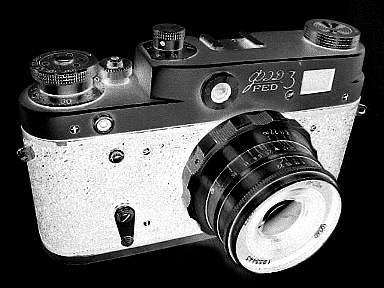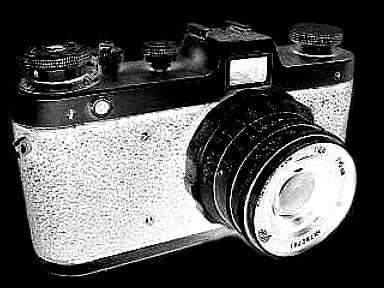
LEICA II
FED 1 (Fedka) 1934 - 1955
The FED name stands for "Felix Edmundovich Dzerzhinsky", also known as Iron Felix. He was one of Stalin's henchmen, a founder of the NKVD and KGB, he died in 1926. The FED 1 is a very close copy of a 1932 Leica II and as so historically the most significant Soviet camera. It was available at a far more realistic price. So aimed at the Soviet mass market and not the elite few as with the Leica in the western imperialist world.
Over a 22 year period manufactured in seven major versions A(1934-35), B(1935-37), C(1937-39), D(1939-45) E(1946), F(1949-53) and G(1953-55)
Specification as 1934 FED 1
Exact copy of a 1932 Leica II.
Camera Type 35mm.
Negative size 24x36mm.
Film loading by removable bottom plate.
Seperate viewfinder and rangefinder
Shutter a la carte Leica
cloth focal-plane (rubberized).
Shutter speeds: Z
- 20th, 30th, 40th,
60th, 100th, 200th, 500th.
Interchangeable lens thread
Leica Type M39 x 26 tpi (threads per inch).
Lens exact copy of Leitz Elmar
collapsible Industar-10 f3.5 50mm (the focal plane is a badly rounded up 50.8mm). Aperture Settings: f3.5,
f4.5, f6.3, f9, f12.5, f18. Focusing: 1.25 metre to infinity. 700K
manufactured.
FOR MORE FED-1 V & S INFORMATION PLEASE CLICK HERE
FED S 1938 - 1941 Based on its
predecessor the FED 1. This camera had a top shutter speed
1/1000th second and an FED f2/50mm collapsible lens. If anybody has any
further details about this camera please email me. 2K manufactured.
FED V 1938 - Based on
its predecessor the FED 1. This camera had a top shutter speed
1/1000s and a slow speed dial on the front, as on the
1935 Leica
IIIa. It also had a FED f2/50mm collapsible lens. It is very
similar in specification to the later Zorki 3. Only 40 (approximately) manufactured.
FOR MORE FED-1 V & S INFORMATION PLEASE CLICK HERE
FED 3 1961 - 1980
This camera came in two distinct versions. The first version was manufactured between 1962 and 1964 and was a very pretty looking camera, as shown in above photograph. Unfortunatly it was a departure from the robust world class FED 2 design, this was in part because it now incorporated slow speeds. This probably marked the end of FED trying to copy Leica products.
Manufactured in four major versions A(1961-63), 3L (1963-69), B(1963-72), and L/D(1977-90).
Specification 1961 - 63 - Type A
Camera Type 35mm.
Negative size 24x36mm.
Film Loading by removable back.
Combined viewfinder and rangefinder.
Curtain shutter a la carte Leica.
Shutter speeds: B - 1s to 1/500s with slow speeds available 1s 1/2s, 1/4s, 1/8s, 1/15.
Flash sychronizer at 1/30s.
Self timer 9 to 15 seconds delay.
Leica Type Lens thread M39
Interchangeable lens typically
Industar-26M f2.8/50mm(52.4mm).
Filter thread size M40.5x0.5.
Diameter for sun shade is 42mm
Focusing: 1 metre to infinity.
700K manufactured
FOR MORE FED-3 INFORMATION PLEASE CLICK HERE
On the 13th July 1949 the Vatican issued a decree threatening excommunications of Catholics who defend and spread the materialistic and ant-Christian doctrine of Communism in Eastern Europe.
Pope
Vatican City
Rome 1949
The second version type B was manufactured between 1964 and 1980 and was an ugly looking brick shaped thing. It had been redesigned for ease of manufacture. However it was still based around that Leica Shutter, Rangefinder and Lens. Which means superb photographs and ease of use. The Industar-61 used a new optical glass that was slightly radioactive.
Specification 1964 - 80 - Type B
Camera Type 35mm.
Negative size 24x36mm
Film Loading by removable back.
Combined viewfinder and rangefinder.
Curtain shutter a la carte Leica.
Shutter speeds: B - 1s to 1/500s with slow speeds available 1s 1/2s, 1/4s, 1/8s, 1/15.
Flash sychronizer at 1/30s.
Self timer 9 to 15 seconds delay.
Leica Type Lens thread M39
Interchangeable lens typically Industar-26m f2.8/52mm(52.4mm) Also Industar 61 (L) Lanthane and Industar 61 L/D.
Filter thread size M40.5x0.5.
Diameter for sun shade is 42mm.
Focusing: 1 metre to infinity.
2 million manufactured.
FOR MORE FED-3 INFORMATION PLEASE CLICK HERE
"Stalin was too crude to exercise the tremendous power that he would acquire" (but it was too late).
Lenin Before his death in 1924
FED 4 1964 - 1976
If you are thinking about buying a Soviet Rangefinder camera, then this is the one for you. A second version Fed 3 with built in light meter. Unfortunatly it is still an ugly duckling, not a camera to impress friends. However it is a superb user camera, as good as any screw thread Leica now available at a knock down bargain price.
Manufactured in two versions A(1964-71) and B(1969-76).
Specification 1964 - 76
Camera Type 35mm.
Negative size 24x36mm.
Film Loading by removable back.
Combined viewfinder and rangefinder
Curtain shutter a la carte Leica.
Shutter speeds: B - 1s to 1/500s with slow speeds available 1s 1/2s, 1/4s, 1/8s, 1/15.
Selenium exposure meter.
Flash sychronizer at 1/30s.
Self timer 9 to 15 seconds delay.
Leica Type Lens thread M39.
Interchangeable lens typically
1963-80 Industar-61 f2.8/52mm(52.4mm)
Filter thread size M40.5x0.5
Diameter for sun shade is 42mm.
Focusing: 1 metre to infinity.
500K manufactured.
FOR MORE FED-4 INFORMATION PLEASE CLICK HERE
'If the Third World War is fought with nuclear weapons, the fourth will be fought with bows and arrows'
Lord
Louis Mountbatten
Member of the Royal Family
FED 2 1955 - 1970
Probably the best Soviet rangefinder camera, especially in its simpler early form when it just felt like the next generation Leica. It existed in 1939 before World War Two as a prototype. It incorporated a Contax type long base rangefinder and removable back for easy film loading. There was also a FED 2 manufactured between 1969-70 in a FED 3 body with an Industar-61 lens. This I believe was marketed as an economic version for the Soviet home market.
Manufactured in six versions A(1955-56), B(1956-58), C(1958-60), D(1958-63), E(1969-70) and 2L(1963-69).
FOR MORE FED-2 INFORMATION PLEASE CLICK HERE
Specification 1955 - 70
Camera Type 35mm.
Negative size 24x36mm.
Film Loading by removable back.
Combined viewfinder and rangefinder.
Long base 67mm rangefinder.
Shutter a la carte Leica.
cloth focal-plane.
Shutter speeds: B - 25th - 500th.
Later 1958 speeds: B- 30th - 500th.
Leica Type Lens thread M39.
Interchangeable lens typically
Early 1955 Collapsible Industar-10 f3.5 50mm - Late 1956 Industar-26m
f2.8 50mm (52.4mm).
Focusing: 1.25 metre to infinity.
2 million manufactured.
ZARYA 1958 - 1959
Zarya translates as 'the dawn'. This camera was based on the FED 2 but without a Rangefinder and was marketed as an economic version for the Soviet home market, as indeed was the MIR. The Zarya is very rare in western Europe as it was not exported. For some stupid reason it was subjected to criticism by the Soviet photographic press, probably because of the lack of rangefinder. There was also a Zarya 3 with an inbuilt optical exposure meter. Less than 100 examples were manufactured and only 60 were ever sold. So if you come across one it could be worth a small fortune. It can be identified by the fact that it has two viewfinder. The FED 2 it is a superb camera, so if you are thinking of buying a new Voightlander Bessa L, please think again this could be a very cheap alternative.
Manufactured in two versions Zarya(1959-61) and Zarya-3(1960).
Specification 1958 - 59
Camera Type 35mm.
Negative size 24x36mm.
Film Loading by removable back
Galilee Viewfinder.
Curtain shutter a la carte Leica.
Shutter speeds: B - 1/30s to 1/500s.
Flash sychronizer at 1/30s.
Leica Type Lens thread M39.
Interchangeable lens typically
Lens Industar-26M f2.8/50mm(52.4mm) Diameter for sun shade is 42mm
Filter thread size M40.5x0.5.
Focusing: 1 metre to infinity.
141K manufactured.
FOR MORE ZARYA INFORMATION PLEASE CLICK HERE
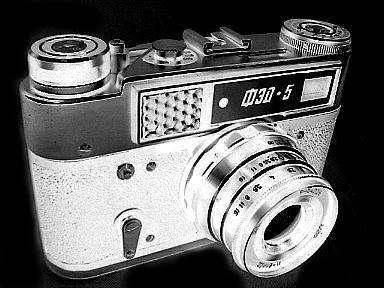
FED 5 1977 - 1990
The FED 5 came in three versions, all based on its predecessor the FED 4. It is a very ugly looking brick shaped camera. The 5 included an exposure meter and the 5B had no exposure Meter. The 5C had an exposure meter and included a bright line viewfinder frame in its rangefinder. The quality of these cameras is very poor, not as well made as the FED 4 or its predecessors. The one I have is a 5B, which exhibits the following faults, uneven shutter curtains, camera case that falls apart and all the controls are out of alignment or loose. This was on a brand new camera. It still however manages to take superb photographs. I cannot recommend this camera.
Manufactured in three versions FED-5 (1977-90), B (1975-90), and C(1977-90).
FOR MORE FED-5 INFORMATION PLEASE CLICK HERE
"Restraint?
Why are you so concerned with saving their lives? The whole idea
is to kill the bastards. At the end of the war if there are two
Americans and one Russian left alive, we win"
General. Thomas Power
Commander of
Strategic Air Command in the 1960's
Specification 1977 - 90
Camera Type 35mm.
Negative size 24x36mm.
Film Loading by removable back.
Combined viewfinder and rangefinder.
Bright line viewfinder frame (FED C).
Curtain shutter a la carte Leica
Shutter speeds: B - 1s to 1/500s with slow speeds available 1s 1/2s, 1/4s, 1/8s, 1/15.
Selenium exposure meter (FED 5 and C).
Flash sychronizer at 1/30s.
Self timer 9 to 15 seconds delay.
Leica Type Lens thread M39.
Interchangeable lens typically
1963-80 Industar-61 f2.8/52mm(52.4mm)
Filter thread size M40.5x0.5
Diameter for sun shade is 42mm.
Focusing: 1 metre to infinity.
500K manufactured.
This FED 5 was the end of the line for Soviet cameras based on the Leica II. As far as I know it is no longer in production. It is a shame as the recent renaissance of the Rangefinder 39mm screw mount camera would have allowed FED as a more polished product sell well.
FOR MORE FED-5 INFORMATION PLEASE CLICK HERE
"Communism, in reality, is not a political party, it is a way of life, an evil and malignant way of life. It reveals a condition akin to a disease that spreads like an epidemic and like an epidemic a quarantine is necessary to keep it from infecting this nation."
J.Edgar Hoover in march 1947 Head of the US Federal Bureau of Investigation 1924-72
FED QUICK LINKS
FED-1 FED-2 FED-3 FED-4 FED-5 FED-6TTL FED-7 FEDKA FAG FED-S FED-V PIONEER TSVVS
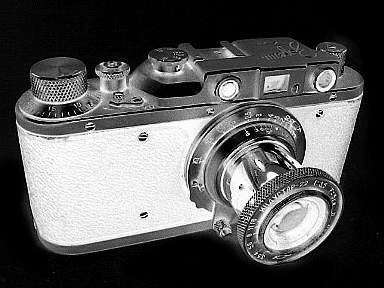
ZORKI 1 1949 - 1956
This camera is a post war copy of the Leica II based on the FED. Manufactured in four versions A(1949-50), B (1950-51), C(1951-53), D(1953-54) and E(1954-56). Not as significant a camera as the FED 1 which had been in production since 1934 albeit developed from it. I am not sure of the total production figures but probably in the region of 300K plus.
"As soon as the war ended, we located the one spot on earth that hadn't been touched by the war and blew it to hell."
Comedian
Bob Hope
Commenting on Atom Bomb testing in the Pacific 1946
Specification 1949 - 56
Exact copy of a
1932 Leica II developed from FED 1 1947-49 at Krasnogorsk Moscow. Negative size 24x36mm.
Lens is a copy of the collapsible
Leitz Elmar f3.5/50mm -
Industar-22 f3.5/50mm.
Lens is screw mount 39mm Leica-type.
Shutter is cloth focal-plane.
Shutter speeds: Z - 1/20s to 1/500s.
Focusing: 1.25 M to infinity.
Coupled rangefinder with a seperate viewfinder. Film again is standard 35mm loading via. a removable bottom. 835K
manufactured.
FOR MORE ZORKI 1 INFORMATION PLEASE CLICK HERE
.
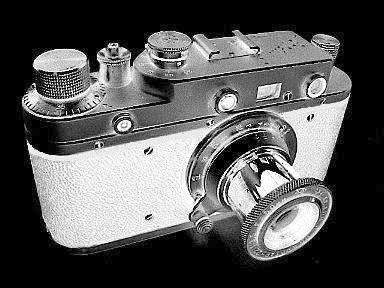
ZORKI S 1955 - 1958
A re-design of the Zorki 1 with flash synchronisation at 1/25s. Still a superb piece of kit, the top of the camera is no longer as pretty but not ugly as in the later camera types. Incorporated shutter setting mechanism with indicator on central shaft and speeds on surrounding cylinder. So it appears to have the ability of setting of shutter speeds armed (meaning cocked shutter) and disarmed, however I would always advise you to cock the shutter before setting the shutter speed.This new mechanism was seen on the Zorki S, 2S, 5 and 6 and ZENIT 3M, B and E and FED 2.
Specification 1955 - 58
Negative size 24x36mm.
Industar-22
f3.5/50mm(collapsible)
Lens is screw mount 39mm Lieca-type.
Shutter is cloth focal-plane.
Shutter speeds: B - 1/25s 1/500s.
Focusing: 1.25 M to infinity.
Coupled rangefinder with a seperate viewfinder.
Film is standard 35mm loading via. a removable bottom 473K manufactured.
"At no time was the
testing out of control" He claimed, quite wrongly, that Lucky Dragon
must have trespassed within the proscribed danger zone and privately
suspected the vessel was a "Soviet spy ship"
Lewis Strauss
Head of the
US Atomic Energy Commission
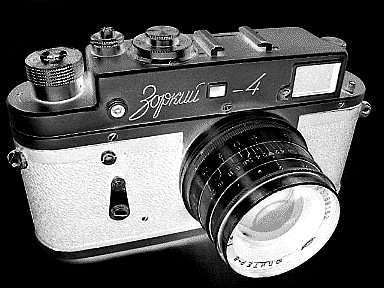
ZORKI
4
1956 - 1973
ZORKI 4K 1972 - 1978
The high point of Soviet rangefinder camera design. It proved without doubt that the Soviet camera industry could rise to the challenge. I wish they had spent some more time and effort on perfecting it. Unfortunatly it is very fragile in use, great care must always be used when setting slow shutter speeds or damage will occur. The self timer is also fragile and if you leave the camera set on a slow shutter speed damage will occur. If you do break it a replacement will cost you next to nothing. The results photographs are as good as any Leica. The 4K included a film transport lever.
'To choose one's victims, to prepare one's plan minutely, to slake an implacable vengeance, and then to go to bed … there is nothing sweeter in the world.'
Josef Stalin Talking to colleagues before he signs 40000 deat warrents.
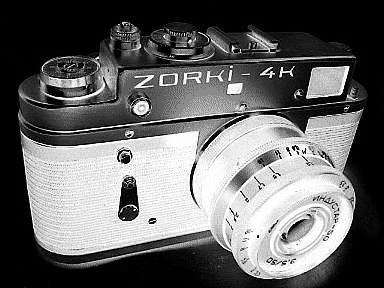
Specification 1956 - 78
Camera Type 35mm
Rangefinder.
Curtain shutter a la carte Leica.
Flash sychronizer.
Self timer 9 to 15 seconds delay.
Negative size 24x36mm.
Film Loading by removable back.
Lens thread is M39x1.
Interchangeable lens typically
Lens Jupiter-8 f2/50mm.
Filter thread size M40.5x0.5.
Diameter for sun shade is 42mm.
Shutter speeds: B - 1s to 1/1000s.
Combined viewfinder and rangefinder.
Focusing: 1 metre to infinity.
Zorki 4k with lever advance.
1.72 million produced
1956-73.
525K Zorki 4k manufactured 1972-78.
' In some sort of crude sense, which no vulgarity, no humor, no overstatement can quite extinguish, the physicists have known sin; and this is a knowledge which they cannot lose.'
J. Robert Oppenheimer Talking at the 'physics in the contemporary world' lecture 25th November 1947.
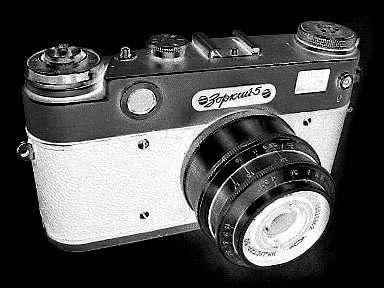
ZORKI 5 1958 - 1959
One of the better Zorki's as it has a similar specification to the superb FED 2. The design was based on the ZORKI 2S, included a new film transport lever, shutter release mechanism as also used in the ZENIT SLR, 3M, B and E. It also had the CONTAX/KIEV type long base 67mm rangefinder as first seen in the FED 2. Not as highly specified as the Zorki 4, it had no slow speeds or self timer. So in theory a better camera as less to go wrong. Film loading was as the Leica II through a removable bottom plate. It came in two versions the first with a square rangefinder window and Industar-22 f3.5/50mm collapsible lens 1958-59. The second 1959 version was very similar to the Zorki 6, with a round rangefinder window and Industar-50 f3.5/50mm lens. The shutter has ability to set speeds armed (meaning cocked shutter) and disarmed
Specification 1958-59
Camera Type 35mm
rangefinder.
Long base 67mm rangefinder (based on FED 2).
Combined viewfinder and rangefinder.
Curtain shutter a la carte Leica.
Shutter speeds: V, 1/25s to 1/500s.
No slow speeds or self timer.
Flash sychronizer.
Negative size 24x36mm.
Film Loading by removable bottom plate.
Lens thread is M39x1.
Interchangeable lens typically
Lens Industar-22 f3.5/50mm collasible (1958-59 v1) - Lens
Industar-50
f3.5/50mm (1959 v2).
Filter thread size M40.5x0.5.
Focusing: 1 metre to infinity.
136K manufactured.
Zorki cameras started by copying the Leica II Rangefinder Camera with Elmar collapsible Lens (circa. 1932). Zorki went on to produce a long line of great cameras culminating in the ZENIT which are still in production today.
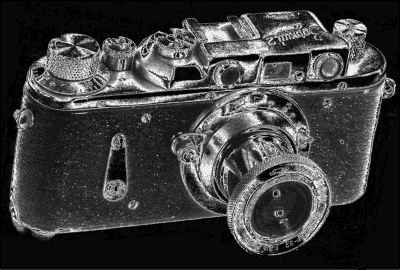
ZORKI 2 1954 - 1956
Specification 1954 - 56
Negative size 24x36mm.
Industar-22
f3.5/50mm(collapsible).
Lens is screw mount 39mm Leica-type.
Shutter is cloth focal-plane.
Self timer 9 to 15 seconds delay.
Shutter speeds: Z - 1/20s to 1/500s.
Focusing: 1.25 M to infinity.
Coupled rangefinder with a seperate viewfinder.
Film is standard 35mm loading via. a removable bottom. 10K manufactured.
ZORKI 2S 1955 - 1960
A second version 2S (or C) was produced between 1955-1960 with adjustable flash synchronisation. The specification is identical to the S. The major advantage was the selftimer. The standard lens was Industar-50 50mm/f3.5 non-collapsible. The examples of the lens I have seen have been of very poor quality. 215000 Produced
"by tomorrow morning the Soviet Union would likely cease to be a major military power or even a major nation. Dawn might break over a nation infinately poorer than China, less populated than the United States, and condemned to an agrarian existence perhaps for generations to come"
Curtis
LeMay
Commander of
US Strategic Air command
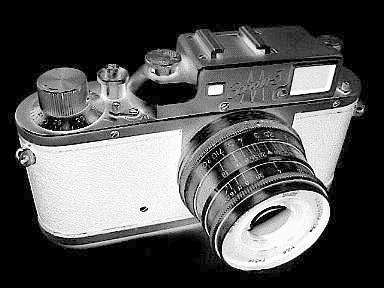
ZORKI 3 1951 - 1954
The Zorki-3 was a real breakthrough. A sort of Leica III copy, it was slightly larger than previous Zorki, but it had many new features that Zorkis had lacked - a bright, large, combined Rangefinder/Viewfinder, a removable back, a diopter adjustment, a set of slow speeds and a high quality fast lens. The Jupiter-8 which was an exact copy of a Zeiss Sonnar. The camera also has a nice flip-up foot, like in the Contax camera. A slow speed mechanism was it seems borrowed from the Leica IIIc, this delay mechanism was located at the bottom of the camera and coupled with the shutter controls with a long rod. The shutter had two dials - on the top of the camera for the fast speeds and a second , on the front for the slow speeds. This Soviet design did not work well and was unreliable. In 1954 a new delay mechanism was introduced. It was located under the top plate and all the speeds were set by the same dial. The Zorki-3 became Zorki-3M.
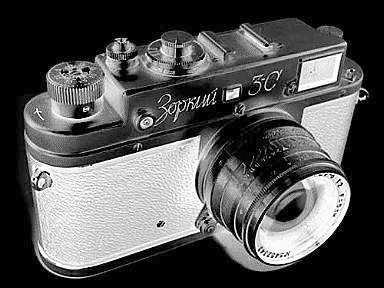
In 1955 all cameras made by KMZ were fitted with a flash synch mechanism. The Zorki-3M with an all new to plate became the Zorki-3S. Then a self-timer was added to this camera in 1956 and it became a Zorki-4.
Specification 1951 - 54
Camera Type 35mm
Rangefinder.
Curtain shutter a la carte Leica.
Negative size 24x36mm.
Flash Synch (3S).
Film Loading by removable back.
Lens thread is M39x1.
Interchangeable lens typically
Lens Jupiter-8 f2/50mm.
Filter thread size M40.5x0.5.
Diameter for sun shade is 42mm.
Shutter speeds: B - 1s to 1/1000s.
Combined viewfinder and rangefinder.
Focusing: 1 metre to infinity.
88K manufactured
with 3, 3M 1951-54.
46K 3S
produced 1955-56.
'From Stettin in the Baltic to Trieste in the
Adriatic, an iron curtain has descended across the continent.'
Winston
Churchill 5th
March 1945.

ZORKI MIR 1959 - 1961
A cut down version of the 4 with no slow speeds and highest shutter speed 1000th removed. Sold this on the Soviet home market.
Specification 1959 - 61
Identical to the
ZORKI 4 -
except no slow or high shutter speeds.
Camera Type 35mm Rangefinder.
Curtain shutter a la carte Leica.
Shutter speeds: B - 1/30s to 1/500s (some 1000) - No slow speeds.
Flash sychronizer.
Self timer 9 to 15 seconds delay.
Negative size 24x36mm.
Film Loading by removable back.
Lens thread is M39x1.
Interchangeable lens typically
Lens Industar-50 f3.5/50mm (home market). Lens Jupiter-8 f2/50mm (for
export). Filter thread size M40.5x0.5.
Diameter for sun shade is 42mm.
Combined viewfinder and rangefinder.
Focusing: 1 metre to infinity.
160K manufactured.
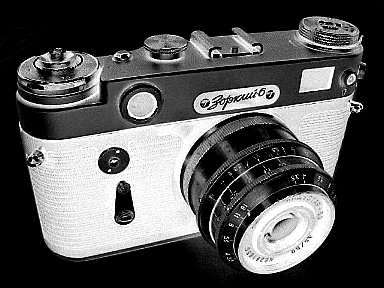
ZORKI 6 1959 - 1966
Identical to the Zorki 5 but with hinged back for easy film loading and self timer. A more advanced shutter with ability of setting speeds armed (meaning cocked shutter) and disarmed. As with Zorki 5 a lot of the features were incorporated into the ZENIT SLR. Possibly the best Zorki as it is of similar specification to the superb FED 2.
Specification
1959-66
Camera Type 35mm
rangefinder.
Negative size 24x36mm.
Film Loading by rear hinged door.Combined viewfinder and rangefinder.
Long base 67mm rangefinder (based on FED 2).
Shutter a la carte Leica.
Shutter speeds: V, 1/25s to 1/500s.
No slow speeds or self timer.
Flash sychronizer.
Lens thread is M39x1.
Interchangeable lens typically
Lens Industar-22 f3.5/50mm collasible (1958-59 v1) - Lens Industar-50
f3.5/50mm (1959 v2).
Filter thread size M40.5x0.5.
Focusing: 1 metre to infinity.
400K manufactured.
"WAS TORN BETWEEN THE ' conviction that our work was crucial in preserving the parity necessary for muttual deterrance' AND THE 'bitterness, shame, and humiliation over the biological and enviromental consequences"
Andrei Sakharov Principle Soviet Nuclear Scientist behind the Superb from his memoirs
ZORKI QUICK LINKS
ZORKI-1 ZORKI-2 ZORKI-3 ZORKI-3M ZORKI-3S ZORKI-4 ZORKI-4K ZORKI-5 ZORKI-6 ZORKI-2C ZORKI-C FED-ZORKI
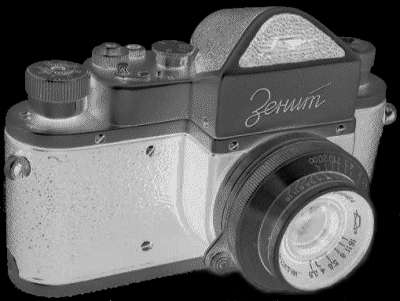
ZENIT (ZENITH) 1951 - 1956
Probably the most significant SLR camera design ever. However because it was of Soviet origin, meaning they were the bad guys. It was totally ignored in the west. The ZENIT SLR was born in 1951, it was a real flash of brilliance by KMZ. Being one of the most compact SLR cameras ever made, it went on to spawn the most descendants. If you are thinking of getting a classic camera this is the one to go for.
Specification 1951-56
As ZORKI 1
except for reflex cage.
Camera Type 35mm Single Lens Reflex.
Curtain shutter a la carte Leica.
Shutter speeds: B - 1/25s to 1/500s.
No slow speeds or Flash sychronizer.
Negative size 24x36mm.
Film Loading by removable bottom plate.
Lens thread is M39x1.
Interchangeable reflex lens (not as Leica RF due to reflex cage width).
Lens Industar-22 reflex f3.5/50mm.
Focusing: 1 metre to infinity.
40K manufactured.
ZENIT S 1955 - 1961
The Zenit S or C was manufactured between 1955-1961 being a minor upgrade incorporating flash syncronisation and a new rewind mechanism as first seen on the Zorki 6. It added a flash synchronization mechanism and a new mirror mechanism. It came with an Industar-50 f3.5 50mm lens. It still had the old style Leica shutter speeds of B, 25, 50, 100, 250,500.
Later versions of the ZENIT S appears to have the ability of setting of the shutter speeds armed (meaning cocked shutter) and disarmed, however I would always advise you to cock the shutter before setting the shutter speed.
Specification 1955-61
Camera
Type 35mm Single Lens Reflex.
Curtain shutter a la carte Leica.
Shutter speeds: B - 1/25s to 1/500s.
No slow speeds.
Flash sychronizer at 1/25s.
Negative size 24x36mm.
Film Loading by removable bottom plate.
Lens thread is M39x1.
Interchangeable reflex lens (not as Leica RF due to reflex cage width).
Lens Industar-22 reflex f3.5/50mm.
Focusing: 1 metre to infinity.
233K manufactured.
ZENIT CRYSTAL 1961 - 1962
Another major re-design incorporating some features from Zorki 5 and 6. With a new modern body designed to ease production and give better protection to the SLR prism. Still with the original Leica shutter and a Zorki 5 setting lever and integrated shutter release. For the first time an opening hinged back for film loading as seen on the Zorki 6. However this model was not a success as it looked like a lorry
'Wether you like it or not, history is on our side. We will bury you'
The ZENIT Crystal appears to have the ability of setting of the shutter speeds armed (meaning cocked shutter) and disarmed, however I would always advise you to cock the shutter before setting the shutter speed.
Specification 1961-62
Camera Type 35mm Single Lens Reflex.
Curtain shutter a la carte Leica.
Shutter speeds: B - 1/30s to 1/500s.
No slow speeds.
Flash sychronizer at 1/25s.
Negative size 24x36mm.
Film Loading via. opening hinged back.
Lens thread is M39x1.
Interchangeable reflex lens (not as Leica RF due to reflex cage width).
Lens Industar-50 reflex f3.5/50mm.
Focusing: 1 metre to infinity.
Self timer 9 to 15 seconds delay.
66K manufactured.
ZENIT 3 1960 - 1962
A major redesign with a new modern body, incorporating some features from Zorki 5 and 6. The Zenith 3 was manufactured from 1960 until 1962. It still had the original Leica focal plane shutter giving speeds from 1/30s up to a maximum 1/500s, and B, a co-axial flash socket and a Zorki 6 self timer. There was no accessory shoe which was surprising considering the complexity of the design. It was supplied with an Industar-50 f3.5 50mm lens. The Zenith 3 cost £29 in 1963, with a Helios-44 f2 58mm lens it was £45. In 1962 there was an export version known as the Zeniflex which was apparently for European distribution. An interesting development of this camera was the turret version with the device permanently fixed to the camera body allowing it to receive 3 lenses.
The ZENIT 3 appears to have the ability of setting of the shutter speeds armed (meaning cocked shutter) and disarmed, however I would always advise you to cock the shutter before setting the shutter speed.
Specification 1960-62
Camera Type 35mm Single Lens Reflex.
Curtain shutter a la carte Leica.
Shutter speeds: B - 1/30s to 1/500s.
No slow speeds.
Flash sychronizer at 1/25s.
Negative size 24x36mm.
Film Loading by removable bottom plate.
Lens thread is M39x1.
Interchangeable reflex lens (not as Leica RF due to reflex cage width).
Lens Industar-50 reflex f3.5/50mm.
Focusing: 1 metre to infinity.
Self timer 9 to 15 seconds delay.
82K manufactured.
'We helped keep the Cold war cold. A war without casuualties cannot be as famous as a horrible war, but is preferable.'
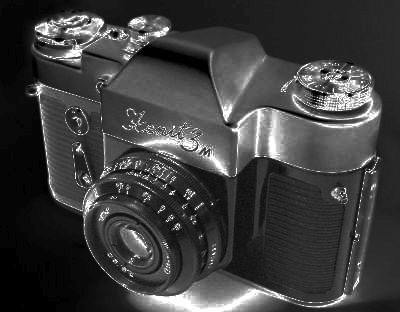
ZENIT 3M 1962 - 1970
The Zenith 3M is very similar to the Zenith 3. It was made from 1962 until 1970. This was another major re-design with a more modern body incorporating a few improvements, notably the lever wind . It was also supplied with a choice of either a Industar-50 f3.5 50mm 4 element lens or a Helios-44 f2 58mm 6 element lens f/2. A special version, not imported into the UK, was made in 1967 and engraved to commemorate fifty years of Communism in Russia. Most significantly it was the Helios 44-2 lens that was the secret weapon that blasted this camera into a unsuspecting cold war world of the 60's and 70's. The rest of the story is history.
The ZENIT 3M appears to have the ability of setting of the shutter speeds armed (meaning cocked shutter) and disarmed, however I would always advise you to cock the shutter before setting the shutter speed.
Specification 1962-70
Camera Type 35mm Single Lens Reflex.
Curtain shutter a la carte Leica.
Shutter speeds: B - 1/25s to 1/500s.
No slow speeds.
Flash sychronizer at 1/25s.
Negative size 24x36mm.
Film Loading via. opening hinged back.
Lens thread is M39x1.
Interchangeable reflex lens (not as Leica RF due to reflex cage width).
Lens Industar-50 reflex f3.5/50mm.
Focusing: 1 metre to infinity.
or Helios-44 and 44-2 reflex f2/50mm.
Focusing: 0.5 metre to infinity.
Both in polished aluminium finish.
Self timer 9 to 15 seconds delay.
782K manufactured.
'We're eyeball to eyeball, and I think the other fellow just blinked'
FURTHER INFORMATION
GENERIC BOTTOM FILM LOADER INFORMATION
FED 1, FED S, FED V, FED-KMZ, FED-Zorki, Zorki 1, Zoki 2, Zorki S, Zorki 2S, Zorki 5, Zenit, Zenit S, Zenit 3, VOOMP I, VOOMP II Pioneer I, pioneer II, VOOMP-GOI, FAG I, FAG II, FAG III, All Leica screw mount cameras.
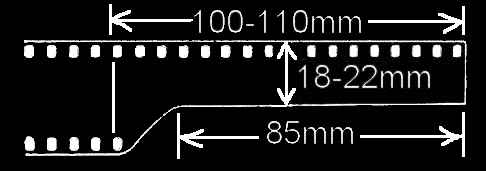
The bottom loading FED 1 requires a Leica style film leader, which is 18 to 22mm wide and 85mm long, and then curves upwards for a total length of 10 or 11 cm WARNING there must be no sharp edges as they will catch on the shutter curtain and damage the rubberized backing.
How to load a film in a Leica Copy
Of the postwar
FED, those from the last of the production runs have the 28,8mm
register. Many Zorki
from the
early to middle batches had variable focus registers. The most consistent so far in this
regard are the
FED whose s/n start at around 49x xxx to the last of the series.
The 50mm lens focal length is a badly rounded up 2 inch (50.8mm). The Leica screw mount is 39mm x
26 tpi(threads per inch) thread of the screw-mount Leica. All the
Soviet cameras with 39mm screw mount are the same as Leica. The earlier
Soviet VOOMP was probably 40x1mm.
GENERIC HANDLING INFORMATION
Warnings apply to all camera types mentioned on this webpage.
WARNING do not set the shutter speed untill you have cocked the shutter. If you do it is possible to do permanent damage to your camera.
WARNING On the FED 2 (most), Zorki C, Zenit 3m types appears to have the ability of setting of shutter speeds armed (meaning cocked shutter) and disarmed, however I would always advise you to cock the shutter before setting the shutter speed.
WARNING do not rotate the shutter speed dial in the interval between: 1/30s and 1s typically on Zorki 4, Fed 3 types or Z (B) and 500th Z - typically Fed 1, Zorki 1, Leica II, Zorki C, Zenit 3m types. Or use excessive force on the shutter setting mechanism.
WARNING you must not point the camera at the sun as it will burn a hole through the shutter curtain! Always use a lens cap.
WARNING never leave the camera permanently set on a slow shutter speed as damage will occur to the camera mechanism. It is a good idea not to leave the shutter cocked permanently as damage may occur to the mechanism.
TECHNICAL LINKS
How to load a film in a
Leica Copy
How
to repair a Leica Copy
How
the Fed shutter works
How
the Leica shutter works
SOVIET CAMERA LINKS
For more detailed information on the Soviet camera you should read the following books or visit the linked websites
5. Fedka
6. Jean Loup Princelle book "The Authentic Guide To Russian and Soviet Cameras Made In The USSR"
Hove Foto Books - French & English Language Editions
7. Ivor Matanle's Classics to use article
"Here Come The Feds" Amateur Photographer Magazine - 26th March 2005
8. Ivor Matanle's book "Collecting & Using Classics SLR's " Thames & Hudson 1997
9. Maizenberg's Repair Books & Articles - In Russian
10. G. Rogliatti book" Leica The First Fifty Years" Hove Camera Foto Books 1975
11. G. Rogliatti book "Leica & Reflex Lenses " Hove Camera Photo Book 1978
12. Dougles St Denny book "Cameras of the People's Republic of China" Jessops Specialist Publishing 1989
13. " Blue book price guide & handbook for collectable cameras" 14th Edition - Hove Foto Books 2003
14. Ronald Spillman AIIP book "Discovering Rewarding Photography The Manual Of Russian Equipment" TOE (London) Ltd. 1971
15. D. R. Grossmark book "The Leica Collectors Guide 1925 - 1960" Hove Foto Books 1981
16. Zenit Camera Group Forum
17. Soviet cameras at Nightphoto
SOFTWARE
This
website is
a work in progress and not that well
organized. My excuse is that I see this as a type
of scrap
book. Also I would like to encourage other wannabe webpage creators into using free software. The next camera I
decide to write about will result in a more polished webpage. I am still on a steep learning curve on how
to use Linux which is great fun. For those interested in free
software
I
suggest the following
NVU
DigiKam GIMP
JAlbum
MEPIS
For MS Windows users I suggest
GIMP Paintdotnet Irfanview
Xnview
I
would advise MS Windows(or Windoz!) users to try Gimp or the Paint.net
option
as I
think these are the best and quickest way to get into free photo
editing without spending loads of money Paint Shop Pro, Elements or
Photoshop. Most of these
options are also available for the Apple Mac OS.
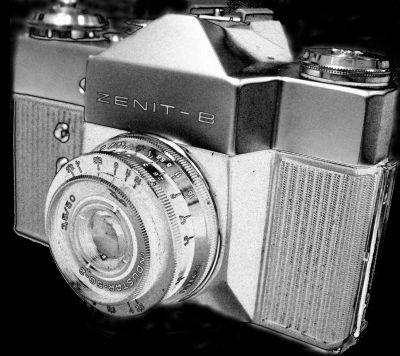
ZENIT B 1968 - 1978
The Zenit B is similar to the Zenith E but does not have the built-in meter. It was produced from 1968 until approximatly 1973. As Soviet exposure meters were unreliable. I think this was the best ZENIT camera simple and fool proof in operation.
Specification 1968-78
Camera Type 35mm Single Lens Reflex.
Curtain shutter a la carte Leica.
Shutter speeds: B - 1/30s to 1/500s.
No slow speeds.
Flash sychronizer at 1/25s.
Negative size 24x36mm.
Film Loading via. opening hinged back
Lens thread M39x1 (early versions).
Lens thread M42 Pentax (later versions).
Interchangeable reflex lens (39mm not as Leica RF due to reflex cage
width).
Lens Industar-50 reflex f3.5/50mm.
Focusing: 1 metre to infinity.
Helios-44, 44-2 f2/50mm.
Focusing: 0.5 metre to infinity.
Both in polished aluminium finish.
Self timer 9 to 15 seconds delay.
890K manufactured.
ZENIT E 1965 - 1982
The Zenith E was very similar to the Zenith 3M incorporating a built in uncoupled selenium exposure meter. This camera incorporated an auto return flash mirror and a redesigned top. A horrible looking SLR which takes superb photographs. Some Zenit E cameras were made between 1965 and 1968 for 39 mm screw fitting lenses without the flash mirror. Most however take the 42 mm screw fitting lenses. It was made, in various versions and commemorative editions, from about 1965 until about 1982 with more than 3 million cameras being produced. There were many commemorative versions and variation on finish. It was normally supplied with the classic Helios-44 58 mm f/2 lens. This camera is still extremely common and very inexpensive to purchase.
'We had a wonderful record on the hydrogen bomb. We tested it, perfected it and never used it - and that served to win the Cold War'
The ZENIT E appears to have the ability of setting of the shutter speeds armed (meaning cocked shutter) and disarmed, however I would always advise you to cock the shutter before setting the shutter speed.
Specification 1965-82
Camera Type 35mm Single Lens Reflex.
Uncoupled selenium exposure meter.
Curtain shutter a la carte Leica.
Shutter speeds: B - 1/30s to 1/500s.
No slow speeds.
Flash sychronizer at 1/25s.
Negative size 24x36mm.
Film Loading via. opening hinged back.
Lens thread M39x1 (early versions).
Lens thread M42 Pentax (later versions).
Interchangeable reflex lens (39mm not as Leica RF due to reflex cage
width).
Lens Industar-50 reflex f3.5/50mm.
Focusing: 1 metre to infinity.
Helios-44, 44-2 reflex f2/50mm.
Focusing: 0.5 metre to infinity.
Both in polished aluminium finish.
Self timer 9 to 15 seconds delay.
3 million manufactured at Krasnagorsk
The Zenit B and E marked the end of the line as the 39mm screw mount was replaced with 42mm. On later Zenit cameras they even used Pentax bayonet mount.
ZENIT QUICK LINKS
ZENIT ZENIT-S ZENIT-3 ZENIT-3M ZENIT-B ZENIT-E ZENIT-CRYSTAL
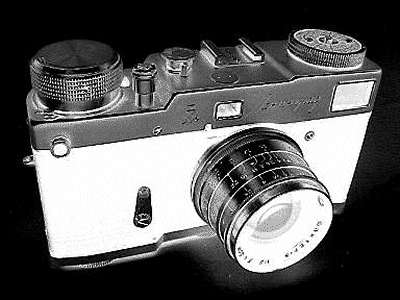
OTHER SOVIET CAMERAS
There are a nunber of other more specialized Soviet cameras based on the Leica shutter and lens mount which I will not be covering here. These include Rodina, Kometa, Drug, Astra and Leningrad.

